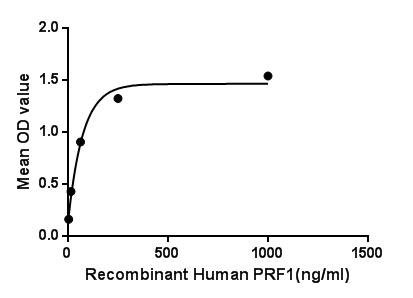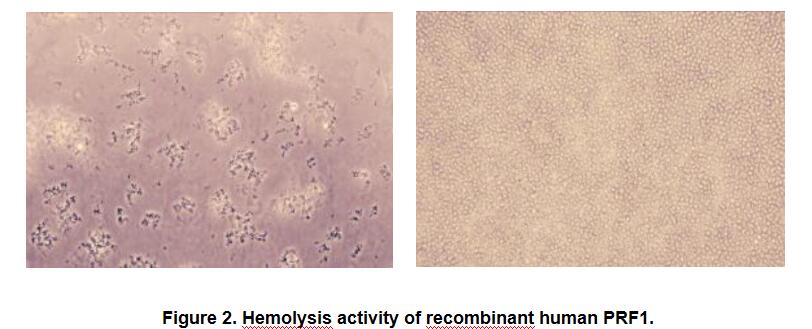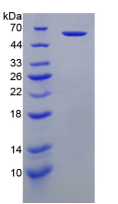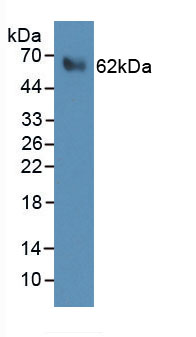Active Perforin 1 (PRF1) 

FLH2; HPLH2; P1; PFP; Pore Forming Protein; Cytolysin; Lymphocyte pore-forming protein
- UOM
- FOB US$ 300.00 US$ 750.00 US$ 1,500.00 US$ 4,500.00 US$ 11,250.00
- Quantity
Overview
Properties
- Product No.APB317Hu01
- Organism SpeciesHomo sapiens (Human) Same name, Different species.
- ApplicationsCell culture; Activity Assays.
Research use only - DownloadInstruction Manual
- CategoryImmune molecule
- Buffer Formulation20mM Tris, 150mM NaCl, pH8.0, containing 1mM EDTA, 1mM DTT, 0.01% SKL, 5% Trehalose and Proclin300.
- Traits Freeze-dried powder, Purity > 95%
- Isoelectric Point7.7
Sign into your account
Share a new citation as an author
Upload your experimental result
Review

Contact us
Please fill in the blank.
Activity test

Figure. The binding activity of PRF1 with CRT.
Perforin 1 (PRF1) is a pore forming cytolytic protein found in the granules of cytotoxic T lymphocytes (CTLs) and NK cells. Upon degranulation, perforin binds to the target cell's plasma membrane, and oligomerises in a Ca2 dependent manner to form pores on the target cell. The pore formed allows for the passive diffusion of a family of pro-apoptotic proteases, known as the granzymes, into the target cell. Besides, Calreticulin (CRT) has been identified as an interactor of PRF1, thus a binding ELISA assay was conducted to detect the interaction of recombinant human PRF1 and recombinant human CRT. Briefly, PRF1 were diluted serially in PBS, with 0.01% BSA (pH 7.4). Duplicate samples of 100μL were then transferred to CRT-coated microtiter wells and incubated for 2h at 37℃. Wells were washed with PBST and incubated for 1h with anti-PRF1 pAb, then aspirated and washed 3 times. After incubation with HRP labelled secondary antibody, wells were aspirated and washed 3 times. With the addition of substrate solution, wells were incubated 15-25 minutes at 37℃. Finally, add 50µL stop solution to the wells and read at 450nm immediately. The binding activity of PRF1 and CRT was shown in Figure 1, and this effect was in a dose dependent manner.

Figure. Hemolysis activity of recombinant human PRF1.
The activity of recombinant PRF1 was measured by lysis of erythrocytes using a hemolysis assay. A general procedure is as fllows: two-fold dilute the recombinant human PRF1 with 0.9% NaCl, add 50μL a serial dilution of PRF1, 10μL 0.1M CaCl2 to each well, then add 50μL 0.25% rabbit erythrocyte (RaE) to each well and mixed gently. Add 10μL 0.9% NaCl to reaplace CaCl2 in control wells. The plate is incubated for 20 hours at 37℃, 5% CO2. The results are shown in Figure 2. It was obvious that the minimal effective concentration of PRF1 is 12.5μg/mL.
(A) 0.25% RaE tread with 12.5μg/mL PRF1 for 20h;
(B) Negative control (0.25% RaE tread with 12.5ug/mL PRF1) without CaCl2.
Usage
Reconstitute in 20mM Tris, 150mM NaCl (pH8.0) to a concentration of 0.1-1.0 mg/mL. Do not vortex.
Storage
Avoid repeated freeze/thaw cycles. Store at 2-8°C for one month. Aliquot and store at -80°C for 12 months.
Stability
The thermal stability is described by the loss rate. The loss rate was determined by accelerated thermal degradation test, that is, incubate the protein at 37°C for 48h, and no obvious degradation and precipitation were observed. The loss rate is less than 5% within the expiration date under appropriate storage condition.
Increment services
-
 BCA Protein Quantification Kit
BCA Protein Quantification Kit
-
 Molecular Mass Marker for Protein
Molecular Mass Marker for Protein
-
 Monoclonal Antibody Customized Service
Monoclonal Antibody Customized Service
-
 Polyclonal Antibody Customized Service
Polyclonal Antibody Customized Service
-
 Protein Activity Test Experiment Service
Protein Activity Test Experiment Service
-
 Electrophoretic Mobility Shift Assay (EMSA) Experiment Service
Electrophoretic Mobility Shift Assay (EMSA) Experiment Service
-
 Buffer
Buffer
-
 Lentivirus Packaging Experiment Service
Lentivirus Packaging Experiment Service
-
 Adenovirus Packaging Experiment Service
Adenovirus Packaging Experiment Service
-
 Real Time PCR Experimental Service
Real Time PCR Experimental Service
-
 Spike RBD Protein (S-RBD)
Spike RBD Protein (S-RBD)
-
 Protein G
Protein G
-
 Protein A
Protein A
Citations
- Granzyme B as a diagnostic marker of tuberculosis in patients with and without HIV coinfectionPubmed:26915636
- The immunoregulatory effects of CD8 T-cell–derived perforin on diet-induced nonalcoholic steatohepatitisPubmed: 30951375
- A novel Granzyme B nanoparticle delivery system simulates immune cell functions for suppression of solid tumorsPubmed: 31695790
- CD317 mediates immunocytolysis resistance by RICH2/cytoskeleton-dependent membrane protectionPubmed: 33223223
- Dual-function chimeric antigen receptor T cells targeting c-Met and PD-1 exhibit potent anti-tumor efficacy in solid tumorsPubmed: 32772342
- Combined treatment with epigenetic agents enhances anti-tumor activity of T cells by upregulating the ACRBP expression in hepatocellular carcinoma34377237
- Cancer-cell stiffening via cholesterol depletion enhances adoptive T-cell immunotherapy34873307
- Single-cell immune profiling reveals functional diversity of T cells in tuberculous pleural effusionPubmed:35061012









